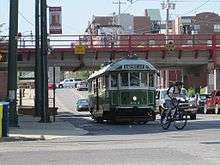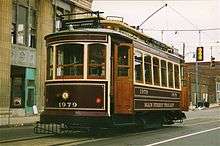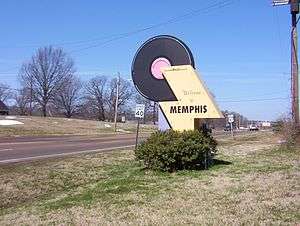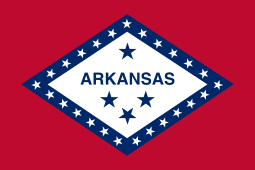MATA Trolley
 Former Porto trolley on the Main Street line. | |
| Operation | |
|---|---|
| Locale | Memphis, Tennessee |
| Open | April 29, 1993[1] |
| Status | Service temporarily suspended |
| Routes | 3 |
| Operator(s) | MATA |
| Infrastructure | |
| Track gauge | 1,435 mm (4 ft 8 1⁄2 in) |
| Propulsion system(s) | Electric |
| Electrification | 600V DC,[2] overhead line |
| Statistics | |
| Track length (total) | 10 mi (16.1 km)[1] |
| Route length | 6.3 mi (10.1 km) |
| Stops | 25 |
| Passengers (2011-2012) |
1.34 million |
| Website | MATA - Trolleys |
The MATA Trolley is a heritage streetcar transit system operating in Memphis in the U.S. state of Tennessee. It began operating on April 29, 1993.[1] Service has been suspended since June 2014, following fires on two cars.[3] As of October 2016, no date has been announced for resumption of service. [4]
The last line of Memphis’ original streetcar network closed on June 15, 1947.[2]
Since opening the system has been extended twice and now consists of three lines; the Main Street Line, the Riverfront Loop and the Madison Avenue Line. These lines are operated by the Memphis Area Transit Authority (MATA). In the 2011–12 fiscal year, 1.34 million trips were made on the system, a 23.1% year-on-year growth—the highest of any light rail system in the contiguous United States.[5]
History

Originally proposed as a 4.9-mile (7.9 km) line along the Mississippi River, the Memphis City Council voted 9-4 in January 1990 to build the 2.5-mile (4 km), $33 million Main Street route.[6] After multiple delays, construction of the line commenced in February 1991 for completion by December 1992.[7] However, due to the longer-than-anticipated restoration of the vintage streetcars, the opening of the line was delayed until spring 1993.[8] After further delay, testing of the first of the restored cars began on March 10, 1993,[9] and the system opened to the public on April 29, 1993.[2][6][1]
On October 1, 1997, the Riverfront line opened.[10] The system's third line, running east from Main Street along Madison Avenue for about 2 miles (3.2 km), opened on March 15, 2004. It was completed at a cost of about $56 million, which was approximately 25 percent below the original budget forecast for the project.[11]
Rolling stock

The trolleys used are almost all restored, vintage streetcars.[6] The original three cars in operation on opening day were all formerly used in Porto, Portugal, and are Car 187, circa 1927; Car 194, circa 1935; and Car 204, circa 1940.[6] These cars are each 30 feet 6 inches (9.3 m) long, 7 feet 10 inches (2.39 m) wide and weigh 25,820 pounds (11.71 t) without passengers. The cars were restored by Kerns-Wilcheck Associates of Memphis.[6] Three additional ex-Porto cars (156, 164 and 180) joined them within weeks, and the fleet had six cars (all ex-Porto single-truckers) by May 1993.[12]

Between the mid-1990s and 2003, the Gomaco Trolley Company supplied an additional ten cars: nine reconditioned Melbourne, Australia W2 class cars and one single-truck car (No. 1979) that was built new by Gomaco in 1993, originally as a demonstrator. There is also car 1794, which was originally an open-sided car from Rio de Janeiro, Brazil, but was heavily rebuilt and enclosed before entering service in Memphis. The most recent addition, in early 2004, is a replica Birney Safety Car, manufactured by Gomaco, the same cars used on the TECO Line Streetcar System in Tampa, Florida.
The fleet and overhead wires were converted from trolley pole to pantograph current collection in early 2003, during a three-month suspension of service which started on January 5, 2003.[13]
Lines
The MATA Trolley network consists of three lines. There are stations at 24 locations (in and out bound stations are counted as a single location) and 35 of the stations are sheltered and ADA accessible.[14]
| Line | Opened | Stations | Length | Termini | |
|---|---|---|---|---|---|
| █ | Main Street Line | 1993 | 13 | 2.0 mi (3.2 km) | Butler Avenue - North End Terminal |
| █ | Riverfront Loop | 1997 | 19 | 4.1 mi (6.6 km) | none |
| █ | Madison Avenue Line | 2004 | 6 | 2.2 mi (3.5 km) | Third Street - Cleveland Station |
Accidents and incidents
On June 1, 2011, two trolleys—A Melbourne W2 class and Porto number 194—traveling on Main Street collided due to a power failure.[15]
Service suspension (2014)
Two of the Melbourne cars caught fire, in December 2013 and April 2014. Both incidents occurred along the Madison Avenue line. In May 2014, the line was shut down in order to conduct an investigation, since the speeds along it are higher. On June 10, the suspension was expanded to include all MATA trolley lines after it was determined much of the fleet would need to be renovated. At that time, the suspension was expected to last at least six months until a feasible solution could be found. Options included restoring the existing fleet at a cost of $6 million, or replacing them with new heritage streetcars at a cost of $40 million.[3] After thorough inspection of the fleet, MATA decided to overhaul several cars rather than purchase new ones, and to eventually reinstate service using only overhauled cars.[16] In December 2014, MATA announced that it was not yet able to give an estimated date for the resumption of service.[17] In March 2015, it was announced that limited trolley service might be possible in May or June, but there was still no timetable for full restoration of service.[18] In October 2016, Memphis Mayor Jim Strickland said trolleys would not be back in service before 2017.[4]
See also
- Memphis Area Transit Authority
- Memphis Suspension Railway
- List of heritage railroads in the United States
- Streetcars in North America
References
- 1 2 3 4 "MATA - Memphis Area Transit Authority - Trolley History". Memphis Area Transit Authority. 2013. Retrieved 2013-08-18.
- 1 2 3 May, Jack (November 1993). "Memphis: Trolleys Roll Again". Passenger Train Journal. Interurban Press. pp. 40–48. ISSN 0160-6913.
- 1 2 Suriani, Mike (June 12, 2014). "MATA Trolleys off the tracks for expensive safety overhaul". WREG-TV. Retrieved 2014-06-13.
- 1 2 Matthews, Mike (2016-10-07). "No Memphis Trolleys This Year". localmemphis.com. Memphis, Tennessee. Retrieved 2016-10-12.
- ↑ Charlier, Tom (November 4, 2012). "Memphis trolleys lead nation in light-rail passenger growth". The Commercial Appeal. Retrieved 2013-03-18.
- 1 2 3 4 5 Huston, Jerry (April 22, 1993). "Trolley rumbles to life in city – Line readied for comeback downtown". The Commercial Appeal.
- ↑ Huston, Jerry (October 15, 1992). "Trolley, mall work nearing an end". The Commercial Appeal.
- ↑ Huston, Jerry (November 26, 1992). "Delays in trolley car restoration move starting date for rail line". The Commercial Appeal.
- ↑ Patterson, Patti (March 11, 1993). "Trolley's test launch thrills cheering, wine-sipping fans". The Commercial Appeal.
- ↑ "MATA offers free trolley rides starting Wednesday". Memphis Business Journal. April 4, 2009. Retrieved 2009-05-31.
- ↑ "Madison rail line to open March 15". Memphis Business Journal. March 11, 2004. Retrieved 2009-05-31.
- ↑ Wilkins, Van (Spring 1996). "Heritage Trolleys in Memphis and Galveston". The New Electric Railway Journal. Free Congress Foundation. ISSN 1048-3845. Retrieved 2011-05-27.
- ↑ Tramways & Urban Transit. UK: Light Rail Transit Association: 146. April 2004. ISSN 1460-8324. Missing or empty
|title=(help) - ↑ "MATA - Memphis Area Transit Authority - Trolleys". Memphis Area Transit Authority. 2013. Retrieved 2013-08-18.
- ↑ Phillips, Bianca (June 1, 2011). "Trolleys Collide at Downtown Intersection". Memphis Flyer. Retrieved 2013-03-18.
- ↑ "Critical questions about temporary trolley suspension" (Press release). MATA. September 26, 2014. Retrieved 2015-01-09.
- ↑ "MATA updates on trolley progress" (Press release). MATA. December 11, 2014. Retrieved 2015-01-09.
- ↑ Dries, Bill (March 12, 2015). "MATA Head Draws Heat on Trolley Delays". The Daily News. Memphis, Tennessee. Retrieved 2015-03-12.
External links
| Wikimedia Commons has media related to MATA Trolley. |
- MATA: Trolley Lines
- A Coordinated Human Services Transportation Plan for the Memphis Area - MATA
- Heritagetrolley.org page on Memphis (APTA)
- Railwaypreservation.com page on Memphis (with many photos)
- Memphis Main Street Trolley (page by Jon Bell)
- Map





